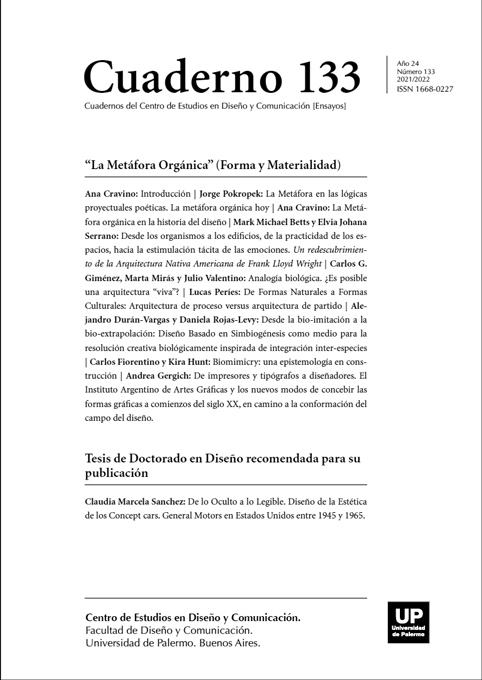Biomimicry: una epistemología en construcción
Resumen
La biomimesis (biomimicry) aún con su metodología y su campo teórico mayormente establecido, no es considerada una disciplina de diseño todavía, o en el mejor de los casos, es sólo considerada como una disciplina emergente. La epistemología de la biomimesis es un proyecto en ejecución, una disciplina en construcción. Este artículo propone una breve revisión conceptual y contextual de la biomimesis, un repaso de su contenido metodológico, y una descripción del presente y futuro de la disciplina emergente.
Citas
Bejan, A. & Zane, J. (2012). Design in nature: How the constructal law governs evolution in biology, physics, technology, and social organization. New York, NY: Doubleday.
Bennett, J. (2010). Vibrant matter: A political ecology of things. Durham, NC: Duke University Press.
Benyus, J. M. (1997). Biomimicry: Innovation inspired by nature. New York, NY: Perennial.
Biomimicry 3.8 (2013). Life’s Principles g6, 2013, https://biomimicry.net/the-buzz/resources/designlens-lifes-principles/Biomimicry Institute, Biomimicry Taxonomy, 2008-2021, https://asknature.org/resource/biomimicry-taxonomy/
Carlson, R. (1961). Silent Spring. New York: Houghton Mifflin.
Fiorentino, C. & Montana-Hoyos, C. (2014). The Emerging Discipline of Biomimicry as a Paradigm Shift towards Design for Resilience. The International Journal of Designed Objects. Champaign, Illinois, USA: Common Ground Publishing LLC 8 (1) 2-15.
Fiorentino, C. (2012). Design for Sustainability vs. Design for Resilience: A Time Scale Problem? The International Journal of Sustainability Education 8, 30-45.
Fry, T. (2017). Design after design. Design Philosophy Papers, 15(2), 99-102.
Gibson, J. J. (1977). The theory of affordances. In R. Shaw & J. Bransford (Eds.), Perceiving, acting, and knowing: Toward an ecological psychology (pp. 67-82). Hillsdale, NJ: Lawrence Erlbaum.
Gibson, L. J.; Ashby, M. F. & Harley, B. A. (2010). Cellular Materials in Nature and Medicine. https://www.cambridge.org/us/academic/subjects/engineering/biomedical-engineering/cellular-materials-nature-and-medicine
Guba, E. G. (1990). The alternative paradigm dialogue. In E. G. Guba (Ed.), The paradigm dialogue (pp. 17-27). Newbury Park, CA: Sage.
Hawken, P. (1994). The ecology of commerce. New York, NY: Harper Business.
How, M. J.; Norman, M. D.; Finn, J.; Wen-Sung, Ch. and Marshall, N. J. (2017). Dynamic Skin Patterns in Cephalopods. https://www.ncbi.nlm.nih.gov/pmc/articles/PMC5474490/
Kant, I. (1999). Practical philosophy. Cambridge, UK: Cambridge University Press.
Kellert, S. R.; Heerwagen, J. & Mador, M. (2008). Biophilic design: The theory, science and practice of bringing buildings to life. Hoboken, NJ: Wiley.
Kennedy, E. B. & Marting, T. A. (2016). Biomimicry: Streamlining the front end of innovation for environmentally sustainable products. Research-Technology Management, 59(4), 40-48.
Leopold, A. (1970). A Sand County almanac: With other essays on conservation from Round River. New York, NY: Ballantine Books.
Lincoln, Y. S. & Guba, E. G. (2000). Paradigmatic controversies, contradictions, and emerging confluences. In N. K. Denzin & Y. S. Lincoln (Eds.), Handbook of qualitative research (2nd ed., pp. 1065-1122). Thousand Oaks, CA: Sage.
McIntosh, A. (2012). The challenge of radical human ecology to the academy. In L. Williams, R. Roberts, & A. McIntosh (Eds.), Radical human ecology (pp. 31-56). Surrey, UK: Ashgate.
Naess, A. (1973). The shallow and the deep, long-range ecology movement: A summary. Inquiry, 16(1-4), 95-100.
Ngoc San Ha & Guoxing Lu (2020). A Review of Recent Research on Bio-Inspired Structures and Materials for Energy Absorption Applications, https://www.sciencedirect.com/science/article/abs/pii/S1359836819339964v
Orr, D. (2002). The nature of design. New York, NY: Oxford University Press.
Sterba, J. P. (2011). Biocentrism defended. Ethics, Policy & Environment, 14(2), 167-169.
Taylor, P. W. (1983). In defense of biocentrism. Environmental Ethics, 5(3), 237-243.
Varela, F. G.; Maturana, H. R. & Uribe, R. (1974). Autopoiesis: The organization of living systems, its characterization and a model. Biosystems, 5(4), 187-196.
Wahl, D. C. (2016). Designing regenerative cultures. Axminster, UK: Triarchy Press.
Wilson, E. O. (Ed.). (1984). Biophilia: The human bond with other species. Cambridge, MA: Harvard University Press.
Woolley-Barker, T. (2013). How would nature create a “generous city”? Retrieved from http://www.triplepundit.com/2013/07/creating-conditions-conducive-life-firstbiomimicry-38-global-conference/
Los autores/as que publiquen en esta revista ceden los derechos de autor y de publicación a "Cuadernos del Centro de Estudios de Diseño y Comunicación", Aceptando el registro de su trabajo bajo una licencia de atribución de Creative Commons, que permite a terceros utilizar lo publicado siempre que de el crédito pertinente a los autores y a esta revista.


